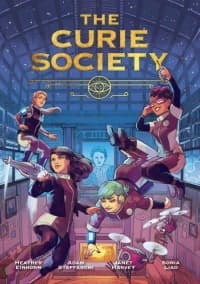
The Curie Society by Heather Einhorn, Adam Staffaroni, Janet Harvey and Sonia Liao
(The MIT Press, 2021)
Reviewed by David Lascelles
‘Charlies Angels but more intellectual’ is my initial reaction to this fascinating experiment in female led comics. Three students—Maya, Taj and Simone—start their first year at Edmonds University in Virginia. Simone is a 16-year-old Biology prodigy with a fascination with ant colonies, Maya is an overachieving maths genius with pushy parents who want her to join MENSA and Taj is an engineer and computer scientist. Our three heroes end up together in the same dorm room and, very soon after arriving, a note is delivered to each of them with a puzzle to solve. The puzzle requires them to work together to find the location of the Curie Society headquarters in the grounds of the University where they discover they are the newest recruits.
The idea of a secret organisation of female scientist spies, founded by Marie Curie, working out of university campuses worldwide and helping to save the world is a solid and worthy one. And the comparison to Charlies Angels is relevant because these aren’t superpowered Avengers style comic book heroes who can blow up buildings with their minds, but rather ordinary and relatable people with incredible smarts and skills who happen to have access to advanced technology and an information network that allows them to intercept problems before they become international incidents. And, instead of being led by an old, white guy who communicates through a telephone, they’re led by someone who they absolutely have to get the actor who played Professor Maggie Walsh in Buffy the Vampire Slayer to play her when they make the movie. Oh, and this character has a prosthetic arm. The concept is one that definitely has legs and potential to be developed into something awesome.
The characters are grounded and realistic and represent a variety of demographics. We have different ethnicities, characters who are homosexual and (I think, it’s not really confirmed) one who at least presents as non-binary, if not actually being so. The plot is interesting in a ‘spy thriller with added science’ way, and though it does depend on some old tropes from the genre it does present them well and occasionally subverts them.
As far as flaws go, the main one is that it somewhat suffers from ‘first season of Star Trek: The Next Generation syndrome’ in that there are occasions where a normal narrative would insert conflict, but it is missing here. In a way this is a good thing—it demonstrates positive interactions for solving differences rather than negative ones—but this can also lead things to being a little flat.
For example, an early incident where a character makes a mistake is handled a little too easily and loses potential to create character development. There is also a tendency to devote whole pages to scientific explanations of something the characters are doing or talking about. Which is great for the goal of educating readers (and which is at least partially the intent here) but can seem a bit preachy sometimes. However, this might be part of the appeal to younger readers.
Overall, this is good stuff and indicative of what ‘comics for girls’ should be rather than (as in the dim and distant past) stuff about romance and nursing. If you were looking for a comic to buy a young, female relative with an interest in science this may be the book you need to get. Over time, I am sure the creators will develop this into something even greater and take us further into the stories of Simone, Maya and Taj as they take up the mantles of full agents of the Curie Society and all the excitement that will entail.
Review from BSFA Review 14 - Download your copy here.
